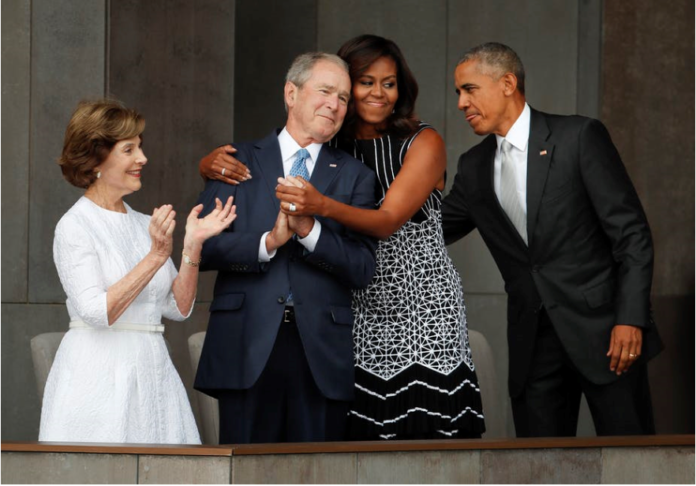

Richard Gunderman, Indiana University
Earlier this month, a video showing George Bush passing candy to Michelle Obama at the funeral of John McCain went viral. That such a simple act of kindness should attract such wide attention is a notable sign of our divided and rancorous times. It reminds us how rare it has become to see people on a national stage treat one another kindly, as if friendship between them were a real possibility. As a physician, I can say that this apparent decline in prospects for friendship presents a real threat to our well-being.
Friendship is more important than many of us know. Aristotle, the person MIT claims exerted more influence in history than any other, declared that it is impossible to live a full human life without friends. Not surprisingly, he devoted a large portion of his most widely read work, “The Nicomachean Ethics,” to the topic. What makes friendship so important to us? What factors enable friendships to thrive? And where can we look for examples of friendship at its best?
Friendship’s benefits
One clear benefit of friendship is good health. A review of 148 studies involving over 300,000 participants found that those with robust social relationships were 50 percent more likely to survive than those with poor ones, a benefit roughly equal to quitting smoking and twice that of regular exercise. Another review found that separation and lack of social contact are strongly associated with a poor sense of well-being.
Such results should not surprise us. Aristotle wrote that human beings are social creatures. Every human infant comes into the world helpless, and it is only by virtue of years of care and child-rearing that any of us reaches maturity. The medical community is just now beginning to understand more clearly the vital role of friendship throughout the human lifespan, not just in the early years but also throughout life.
While it is possible to identify some generic features of thriving friendships, one of the best ways to understand the full richness and complexity of such relationships is to study the stories of great friends. Western literature brims with examples – Homer’s Achilles and Patroclus, the Bible’s Jonathan and David, and Jane Austen’s Charlotte and Elizabeth. But recent American history has furnished its own shining examples.
Dorothy and Peter
Consider one of the most remarkable American friendships of the 20th century, Dorothy Day (1897-1980) and Peter Maurin (1877-1949). Together they would found a movement known as the Catholic Worker, which still operates 220 houses of hospitality across the U.S.
As a young woman, Dorothy Day led a bohemian life, experiencing numerous love affairs, a failed marriage, suicide attempts and an abortion. With the birth of her daughter in 1926, she turned from her atheist common law husband to answer a religious calling. A gifted writer, she recounted her remarkable story in her 1952 autobiography, “The Long Loneliness.”
Peter Maurin was born to a poor working family in France and immigrated to America, where he worked as a French tutor. In the 1920s, inspired in part by the life of St. Francis of Assisi, he underwent a religious conversion, after which he embraced poverty as a gift from God and worked at menial jobs for room and board. Peter liked to contrast the contemporary view of beggars as bums with the ancient Greek view that they are the ambassadors of the gods.
Dorothy and Peter met in 1932. She was a journalist who had just returned from covering a hunger march in Washington, D.C., hungering herself for some cause to which she could devote her life. He was a street-corner prophet with big ideas who had failed to gain traction. She saw in him the answer to her prayers for a purpose in life, and he saw her as a person whose words and works could attract thousands to the cause.
In 1933, their new friendship really began bearing fruit. Peter suggested she start a newspaper, the Catholic Worker, which published its first issue on May 1, selling for a penny a copy. His ideas also served as the inspiration for houses of hospitality for the poor. By living with and serving the poor, Dorothy, Peter and those they attracted to the movement would not only talk and write about their ideas but also live them every day.
Dorothy and Peter could hardly have been more different. He was short, an immigrant, shabbily dressed, his pockets bulging with newspapers and pamphlets, his mind on fire with ideas. She was tall and striking, a cigarette often dangling from her mouth, and could readily inspire others to action.
Features of great friendship
Their friendship flourished first because they shared a common purpose. Such purposes might include building a thriving family, creating a business partnership, or simply bringing out the best in each other. Dorothy and Peter believed that they had been put on earth “to give people the vision of a society in which it is easier for people to be good.” Great friendship means more than enjoying one another’s company. It means sharing a vision and working to achieve it.
Second, instead of dividing them, their differences brought them more closely together. They complemented one another – Peter the absent-minded dreamer who lived in ideas, and Dorothy the activist whose street battles would land her in prison multiple times. Peter delighted in the title of agitator, but it was primarily Dorothy who would build the movement’s momentum. Each was a formidable force, but together they produced results far beyond the mere sum of their parts.
Third, their relationship depended on something far deeper than romance. Each was keenly aware of the differences between men and women, and they occasionally teased each other about them. For example, when Dorothy rejected Peter’s original name for the newspaper, he responded, “Man proposes and woman disposes.” But because they shared a deep commitment to a common purpose, each tended to find in the quirks of the other cause not for consternation but delight.
Fourth, they regarded their relationship not as a secret to be jealously guarded for their own private enjoyment, but a renewable resource that could only grow through the sharing. Wrote Dorothy, “Heaven is a banquet and life is a banquet, too, even with a crust, where there is companionship.” At first several, then dozens, and eventually hundreds of young people joined the movement. As it unfolded, they found their shared mission not diluted but intensified.
Finally, they both loved books and conversation. Peter read the Bible and the Lives of the Saints, to which Dorothy added the novels of Dickens and Tolstoy. She would frequently get to know visitors by asking them to name their favorite of Dostoevsky’s novels. They regularly discussed such books and ideas at roundtable discussions, which helped to clarify their thinking and inspire their mission. To them, reading and conversation were not pastimes. They were means of discerning and affirming life’s purpose.
Building friendships
Our fascination with a simple act of human kindness between political rivals reveals our longing to see and experience friendship. But friendship, like love, is not a dish that can be reliably prepared merely by following a recipe. To find genuine friendship and reap the many benefits it can sow, we need to explore the elements of great friendship, including a common sense of purpose, a commitment to complementarity, a delight in difference, a summons to share and a love of learning.
Perhaps the greatest wonder of friendship comes through community. Dorothy Day said, “We have all known the long loneliness, and we have learned that the only solution is love and that love comes with community.” As MIT’s second-most influential human being, Plato, wrote in his dialogue “Symposium,” in isolation we are incomplete. It is only in the union of friendships that we stand a chance of leading truly complete lives.![]()
Richard Gunderman, Chancellor’s Professor of Medicine, Liberal Arts, and Philanthropy, Indiana University
This article is republished from The Conversation under a Creative Commons license. Read the original article.



















